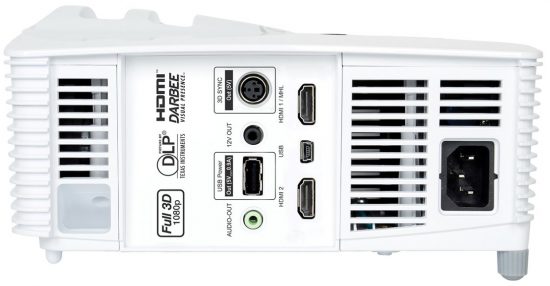Tech Review: Optoma HD28DSE Projector
I recently had the chance to test out the Optoma HD28SDSE projector. Once again I was very impressed, although it did take some messing around with the various settings to get the best out of it.
Here is a bit of the official blurb to give you the basics:
Optoma revolutionises home projection with intense detail approaching Ultra HD picture quality. Critically acclaimed Darbee Visual Presence image processing, coupled with Optoma’s legendary projection technology dramatically intensifies image quality. This provides the flexibility to fine tune the projector for a clearer, sharper and a simply stunning visual experience. Perfect for movies, gaming and sports.
With two HDMI inputs and built-in speaker, the HD28 Darbee Special Edition is easy to setup and use. It can even be turned into a smart projector by connecting a smartphone or tablet with a single cable using MHL to stream videos, play games and share photos on the big screen.
Like all the other Optoma projectors I have reviewed, this was nice and easy to set up. Plug in the Blu-ray Player or console, switch it on and you are pretty much good to go. For connections it has a side panel that features two HDMI slots, a 3.5mm audio output, a 3D sync slot, 12V trigger and a mini-USB. The dimensions are 315 x 114 x 223mm and it weighs 2.5kg so it is nice and easy to move around.
Depending on where you are using the projector, you may need to alter the size of the projected image to fit the screen or wall, but that was simply done. If necessary you can also adjust the keystone on the horizontal and vertical plane or individually warp each corner of the image to create a perfectly square image. Ideal for uneven walls or where projector placement is awkward and needs to be installed at an angle.
The main feature about this projector, apart from it being a nice entry level price-wise, is the image quality. The Darbee Visual Presence technology is there to produce extraordinary levels of detail, depth, lighting and object separation. It also has BrilliantColour image presets and the HD28DSE’s 3,000 ANSI Lumens lamp means it can be used in anything but the brightest of daylight. The lamp is also rated to last for 8,000 hours which is amazing.
How does that work in practice? At first, I was not that impressed. Some of the picture preset options of the Darbee setting just did not work for me. The Full Pop made the image look too bright in places and colours seemed to bleed into each other, especially on skin tones. Some dark areas just became all black meaning you could not see any details in those areas. However, working through the different presets I found that the Hi-Def setting worked extremely well. Suddenly the picture quality was super detailed without losing any clarity and the colours calmed down. You can also alter the specific settings of the Darbee to get that perfect image. It also has a couple of demo settings, which means you can see just what the difference is with the Darbee tech working compared to the basic image. It can either split the screen or have a wipe effect that goes back and fourth.
Doing this you can really see how amazing the image quality can be. Suddenly you are seeing details that just were not there before. When you get it set just right it can produce incredible picture quality.
Basically, when you first try it out, go through the various presets until you find the one that works for you. You may also need to change them depending on what your input source is – video game or Blu-ray – and what time of day you are using it.
Digging deeper you can really fiddle with the settings to get the perfect picture to suit your preferences. It does come with a Dynamic Black feature. This increases the projector’s light output in response to changes in the image content. This is to boost dynamism and the black-level response. I have never really liked this option in any projector as I always seem to notice it changing and it can become a distraction. I usually switch it off, which can lead to some of the darker areas looking greyer, but you can alter the level of response so it may work for you.
I did also notice a few rainbow effects – flashes of red, green and blue – it usually happened if I was turning to look at the remote control or moving in or out of the room. However, it did not happen often and was easy to live with.
The inbuilt speaker does give you a few more options for placement, but they are never the best sources of sound so you will want to try and have your media playing through a dedicated sound system.
The projector worked very well for video games, but again you have to play around with the settings to get that perfect picture. Once you do get it just right you can save it as a personal preference.
I can highly recommend the Optoma HD28DSE. It is a decent price if you are considering making the move to a projector. Sure you may have to dig a little deeper into the settings than other models, but when you hit that sweet spot the image quality can take your breath away.
Specifications:
| Display Technology | DLP |
| Native Resolution | 1080p 1920 x 1080 |
| Brightness1 (Bright Mode) | 3000 ANSI Lumens |
| Contrast | 30,000:1 |
| Lamp Life2 Dynamic/Eco/Bright | 8000/6000/4000 (hrs) |
| Throw Ratio 3 | 1.48 – 1.62:1 |
| Zoom Type | 1.1x Manual |
| I/O Connectors | 2 x HDMI (1.4a 3D support) + MHL v1.2, Audio Out 3.5mm, 12V trigger, 3D-Sync, USB-A Power (0.9A), USB service |
| Speaker | 10 |
| Keystone Correction | ± 40° Vertical and Horizontal |
| Weight (kg) | 2.58 |
| Dimensions (W x D x H) (mm) | 315 x 224 x 114 |
| Aspect Ratio | 16:9 Native, 16:10/4:3 Compatible |
| Offset | 116% ±5% |
| Projection Screen Size | 1.06 – 7.67m (41.8″ – 300″) Diagonal 16:9 |
| Projection Distance | 1.5 – 10m |
| Projection Lens | F/2.5~2.67; f=21.9~24mm, 1.1x Manual Zoom |
| Uniformity | 80% |
| Computer Compatibility | UXGA, SXGA, WXGA, HD, XGA, SVGA, VGA, Mac |
| Video Compatibility | 1080p, 1080i, 720p, 576i/p, 480i/p |
| 3D Support | Full 3D – The 3D features of Optoma projectors can only be used with compatible 3D content. Typical applications include use with 3D educational or 3D design and modelling systems. 3D TV broadcast systems, (SKY in the UK), Blu-ray 3D™ and 3D games from the Sony® PS3 or Microsoft® Xbox 360 are now supported as part of the HDMI v1.4a specification. |
| 3D Compatibility | Side-by-Side:1080i50 / 60, 720p50 / 60 Frame-pack: 1080p24, 720p50 / 60 Over-Under: 1080p24, 720p50 / 60 |
| Horizontal Scan Rate | 15.375~91.146 KHz |
| Vertical Scan Rate | 24 ~ 85Hz (120Hz for 3D) |
| Displayable Colours | 1073.4 Million |
| Noise Level (Eco mode) | 28dB |
| Power Supply | Input: 110 – 220v |
| Power Consumption | 233W Bright mode / 193W Eco mode (< 0.5W Standby) |
| Lamp Type | 210W |
| Operating Conditions | 5°C – 40°C, Max. Humidity 85%, Max. Altitude 3000m |
| Security | Security bar, Kensington lock, password protection |
| On Screen Display | 27 Languages: English, French, German, Spanish, Italian, Portuguese, Dutch, Swedish, Finnish, Greek, Danish, Norwegian, Polish, Russian, Simplified_Chinese, Traditional_Chinese, Korean, Arabic, Japanese, Thai, Hungarian, Czechoslovak, Turkish, Vietnamese, Farsi, Romanian, Indonesian |
| Standard Accessories | AC power cord, remote control, 2x AA batteries, quick start card, CD user manual |
| Optional Accessories | Wireless 3D system, Wireless 3D glasses, DLP® Link™ 3D glasses, wireless, ceiling mount |
| Optional Wireless | Yes |
| Warranty | 2 Years |
| RoHS | Compliant |












